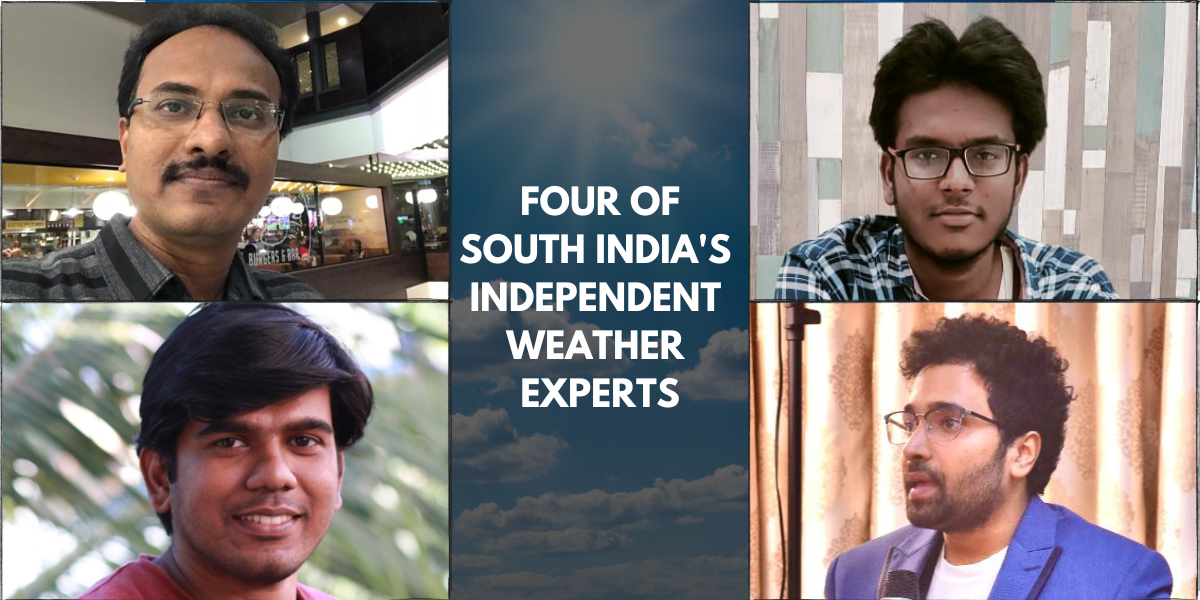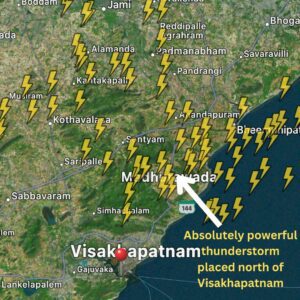Several amateurs have emerged in the past few years. All they want is to present the most accurate information on India’s weather patterns.

Four of South India's independent weather experts. (Supplied)
India is experiencing a warmer climate, unusual and unprecedented spells of rain, and colder winters in some parts. And what better way to reach out to the public about this grave situation than through movies?
In the recent past, several Indian films have been released to illustrate the wrath of climate change. Jude Anthany Joseph’s 2018, a Malayalam survival thriller based on Kerala’s catastrophic floods that same year, joined the bandwagon recently.
Thanks to these movies, Indians are growing interested in learning more about the country’s changing weather patterns. And there is a tribe of amateur weather experts who are catering to this demand, using social media platforms to simplify complex concepts about the climate, and to offer accurate forecasts.
We curate a list of our favourite “unofficial” weathermen, some of whom are as popular as the “official” India Meteorological Department (IMD).
Chennai-based Raja Ramasamy has been working in the IT software field for 24 years. And while he loves his full-time job as a product head, his love for weather tracking runs equally deep.
For as long as he can remember, Ramasamy has been passionate about weather analysis. “I think I first got interested in this field when I was only 10,” he recalls.
In the last 35 years, he has dedicated ample time to analysing weather. Ramasamy took his passion to another level in November 2009 by launching a Twitter handle called Chennai Weather. He posts regular weather updates on this page, which today has a whopping 130.4K followers.
“The main agenda behind starting the Twitter page was to pass on vital information to fellow citizens,” he informs. “This is merely public service; I am not a professionally-trained weather forecaster.”
Ramasamy’s popularity grew when he posted accurate weather forecasts during the 2015 Chennai floods. People took notice as his updates arrived before official reports from government agencies. He had only 4,000 followers then.
“I remember tweeting from the terrace of my home as the mobile signal was very weak at the time,” he says of the event in which Chennai witnessed unprecedented flooding as a result of heavy rainfall.
Today, several celebrities and government officials follow his page, validating Ramasamy’s predictions. “Many people plan open air events, like weddings, based on the information I post on the Twitter account,” he says, adding, “Some of my followers include state ministers, CEOs, and even CHROs (chief human resource officers.”
Curating information for his passion project sometimes gets difficult as the weather in Chennai is “very dynamic”, he says.
“Chennai weather is hard to predict, but forecast models and weather charts along with my experience in this field makes the job easier!”
Hyderabad-based T Balaji is just 18 years old. Currently a second-year BTech student at Jawaharlal Nehru Technological University, Balaji was 16 when he started the Twitter and Instagram pages called Telangana Weatherman.
“When I started the pages during the first wave of the pandemic, I named the project ‘Hyderabad Weatherman’. But later, I changed it to Telangana Weatherman,” he tells South First.
Balaji has loved rain-watching and cloud-reading since he was a child. “Through the naked eye, I would observe the formation of clouds, their depth, colour, size, and would predict whether it would rain in the region,” he recalls.
By the time he was in Class 9, his interest in weather analysis grew. He turned to books, geography, and weather blogs to gain more knowledge. “When the Covid-induced lockdown happened, I was in Class 12. Suddenly I had a lot of free time, so I decided to use social media to disseminate information.”
Balaji would also interact with other independent weather enthusiasts based in southern India to hone his skills.
“I do two types of analysis. In the ground analysis, I check how winds are blowing, how clouds are forming, humidity variations, and other temperature-related factors. I also track scientific models of international and national agencies that present forecasts.”
Balaji’s Twitter and Instagram handles have 44.6k and 10.4k followers, respectively.
“I share forecasts out of interest and enthusiasm,” he says.
“I don’t want to compare my work with IMD. There is a whole community of independent weather enthusiasts like me. We don’t have degrees in meteorology or anything. I don’t intend to make a career out of this either. Most of my predictions are accurate and that is why people follow me.”
Cloudy skies in Hyderabad and isolated showers expected at one or 2 places. However most of the places to remain silent#HyderabadRains
— Telangana Weatherman (@balaji25_t) May 25, 2023
Tirupati-born Sai Praneeth Burrah is an enthusiastic weather blogger. Currently working as a senior engineer at Robert Bosch in Bengaluru, Burrah goes by “Andhra Pradesh Weatherman” on Twitter, Instagram, and his website.
“I started blogging about weather when I was 15, in 2011,” he says. This was when Cyclone Thane had struck Tamil Nadu, causing severe damage to infrastructure and loss of lives.
“Around that time, I joined an excellent community of weather bloggers called the Kea Weather Blog. These bloggers, mainly from in and around Tamil Nadu, were posting their day-to-day analysis. We held interesting debates and case studies of each and every heavy rainfall event or a cyclone and would predict what is to happen next.”
Since then, Burrah’s passion for weather blogging has become more serious. What started as a weekly activity is now a day-to-day affair for him. He started his Twitter and Instagram handles in 2020.

Visual created by Burrah shows powerful thunderstorm closing Vishakhapatnam on 22 May 2023. (Supplied)
“I realised that a large volume of people in Andhra Pradesh are unaware about how weather events affect their lives. I wanted to take up the responsibility of making them more aware via my accurate findings. I began with posting forecasts on Facebook and YouTube. This was in Telugu, to be better understood by the locals. When I felt like I had built enough trust among my followers, I launched Twitter and Instagram handles.”
Burrah’s rise-to-fame moment was when Prime Minister Narendra Modi praised his efforts during his Mann Ki Baat radio programme. Burrah has a large following of 71K on Twitter and 115K on Instagram today.
“My forecasting is different for rural and urban areas,” he explains. “The city predictions mainly depend on real-time updates. I keep this blog active every hour so that people can plan a few hours in advance. For rural forecasting, I ensure that I warn my followers at least two weeks in advance so they can plan before harvesting crops.”
Burrah’s role model is the most respected and sought-after independent weather expert Pradeep John, popularly known as the Tamil Nadu Weatherman. “He used to teach me the basic concepts of weather. He is very passionate about weather,” Burrah tells South First.
HEAT AHEAD FOR CENTRAL AP
—
Hot Weather to dominate most parts of #AndhraPradesh Today as there are more direct dry winds coming from Telangana and this will cause Heat-Wave weather conditions over Central parts of the state mainly NTR (Vijayawada region), Krishna, #Eluru,… pic.twitter.com/bIP6dRENkx— Andhra Pradesh Weatherman (@APWeatherman96) May 26, 2023
Nagercoil-based Raj Bhagat Palanichamy has a background in civil engineering and Earth observation, including GIS (Geographic Information System) and remote sensing. Palanichamy runs a Twitter account to post informative and detailed maps related to Earth observations. He creates valuable stories around these maps to help people make decisions better.
For instance, a map he created in early May shows how a canal breached following heavy rains, resulting in water overflowing outside the streets of Padma Colony in Hyderabad. Another map shows daily maximum heat stress faced by citizens over one year in India.
“I probably drew my first map when I was 6, and those were usually maps of Tirunelveli and Nagercoil, the bus routes between them. I was also the state topper in Tamil Nadu in Social Sciences (Geography, History, and Civics). So, the stage was all set for me to be working in maps. I pursued education in these directions,” the 35-year-old tells South First.
Palanichamy currently works as a senior programme manager with the GeoAnalytics team for WRI India, a research-to-action organisation in Bengaluru. A lot of the maps that you see on his Twitter are originally made for a professional purpose. Why did he want to share his work with the public, we ask.
“I started posting maps on Twitter 4-5 years ago. I was inspired by the work of Pradeep John and Srikanth (ChennaiRains). Though their fields were different, the way they connected with public with scientific information made me realise that I was not doing what I should be doing.
“I was sitting on top of a treasure trove of information, stories that people needed to know and hear. Then I began experimenting with the posts and began creating stories out of the research that we did and started connecting with the audience through maps.”
Few days ago, when it rained heavily, the water from the canal breached the retaining wall and began flowing outside into the streets of Padma Colony (flooded areas marked in red) . Residents blamed it on corporation. Corporation blamed it on encroachments. pic.twitter.com/kUCuhBbzJA
— Raj Bhagat P #Mapper4Life (@rajbhagatt) May 10, 2023
Palanichamy’s Twitter account has 39.9k followers today. He takes us through the mapping process.
“There are four components in a mapping process — Purpose, Science, Technology, and Art. We need to identify the purpose of the mapping, the story that we want to convey, and then start with the science and the data part of it,” he tells South First.
“Then comes the technology aspect of mapping. But the most important aspect of a mapping project is the art component. Learning new information is a great skill, but an even better skill is the ability to convey and communicate what has been learnt.”
And so, before he creates these maps, Palanichamy imagines himself sitting in the audience and seeing those maps for the first time and trying to make sense out of it.
“I always wanted great stories for the maps which people can relate to and understand,” he says.

Apr 19, 2024

Apr 19, 2024

Apr 19, 2024

Apr 19, 2024

Apr 19, 2024